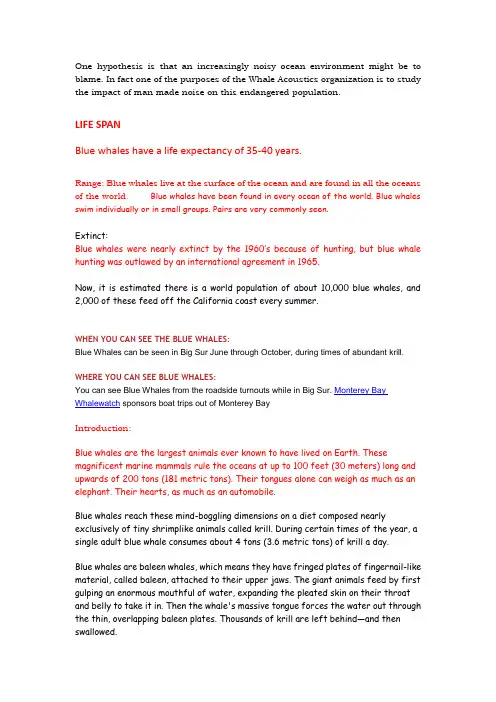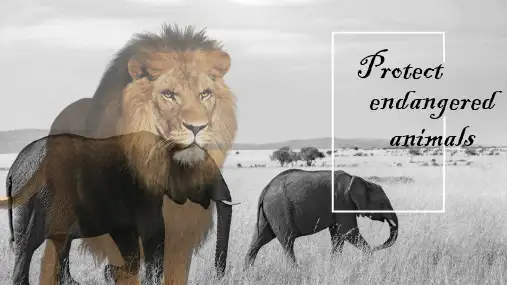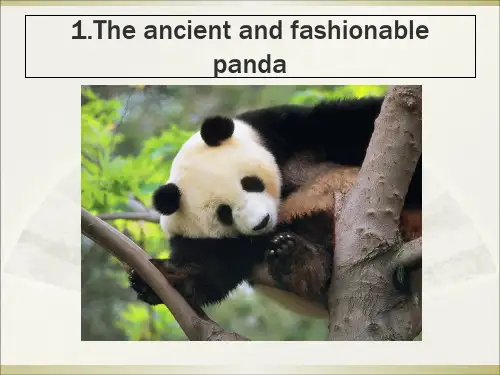濒危动物英文ppt课件
- 格式:ppt
- 大小:1.31 MB
- 文档页数:16

One hypothesis is that an increasingly noisy ocean environment might be to blame. In fact one of the purposes of the Whale Acoustics organization is to study the impact of man made noise on this endangered population.LIFE SPANBlue whales have a life expectancy of 35-40 years.Range: Blue whales live at the surface of the ocean and are found in all the oceans of the world. Blue whales have been found in every ocean of the world. Blue whales swim individually or in small groups. Pairs are very commonly seen.Extinct:Blue whales were nearly extinct by the 1960’s because of hunting, but blue whale hunting was outlawed by an international agreement in 1965.Now, it is estimated there is a world population of about 10,000 blue whales, and 2,000 of these feed off the California coast every summer.WHEN YOU CAN SEE THE BLUE WHALES:Blue Whales can be seen in Big Sur June through October, during times of abundant krill.WHERE YOU CAN SEE BLUE WHALES:You can see Blue Whales from the roadside turnouts while in Big Sur. Monterey Bay Whalewatch sponsors boat trips out of Monterey BayIntroduction:Blue whales are the largest animals ever known to have lived on Earth. These magnificent marine mammals rule the oceans at up to 100 feet (30 meters) long and upwards of 200 tons (181 metric tons).Their tongues alone can weigh as much as an elephant. Their hearts, as much as an automobile.Blue whales reach these mind-boggling dimensions on a diet composed nearly exclusively of tiny shrimplike animals called krill. During certain times of the year, a single adult blue whale consumes about 4 tons (3.6 metric tons) of krill a day.Blue whales are baleen whales, which means they have fringed plates of fingernail-like material, called baleen, attached to their upper jaws. The giant animals feed by first gulping an enormous mouthful of water, expanding the pleated skin on their throat and belly to take it in. Then the whale's massive tongue forces the water out through the thin, overlapping baleen plates. Thousands of krill are left behind—and then swallowed.Blue whales look true blue underwater, but on the surface their coloring is more a mottled blue-gray. Their underbellies take on a yellowish hue from the millions of microorganisms that take up residence in their skin. The blue whale has a broad, flat head and a long, tapered body that ends in wide, triangular flukes.Blue whales live in all the world's oceans occasionally swimming in small groups but usually alone or in pairs. They often spend summers feeding in polar waters and undertake lengthy migrations towards the Equator as winter arrives.These graceful swimmers cruise the ocean at more than five miles an hour (eight kilometers an hour), but accelerate to more than 20 miles an hour (32 kilometers an hour) when they are agitated. Blue whales are among the loudest animals on the planet. They emit a series of pulses, groans, and moans, and it’s thought that, in good conditions, blue whales can hear each other up to 1,000 miles (1,600 kilometers) away. Scientists think they use these vocalizations not only to communicate, but, along with their excellent hearing, to sonar-navigate the lightless ocean depths.Really Big BabiesBlue whale calves enter the world already ranking among the planet's largest creatures. After about a year inside its mother's womb, a baby blue whale emerges weighing up to 3 tons (2.7 metric tons) and stretching to 25 feet (8 meters). It gorges on nothing but mother's milk and gains about 200 pounds (91 kilograms) every day for its first year.Blue whales are among Earth's longest-lived animals. Scientists have discovered that by counting the layers of a deceased whale's waxlike earplugs, they can get a close estimate of the animal's age. The oldest blue whale found using this method was determined to be around 110 years old. Average lifespan is estimated at around 80 to 90 years.Between 10,000 and 25,000 blue whales are believed to still swim the world's oceans. Aggressive hunting in the 1900s by whalers seeking whale oil drove them to the brink of extinction. Between 1900 and the mid-1960s, some 360,000 blue whales were slaughtered. They finally came under protection with the 1966 International Whaling Commission, but they've managed only a minor recovery since then.Blue whales have few predators but are known to fall victim to attacks by sharks and killer whales, and many are injured or die each year from impacts with large ships. Blue whales are currently classified as endangered on the World Conservation Union (IUCN) Red List.COLOR: The blue whale is blue-gray in color, but often with lighter gray mottling on a darker background (or with darker spots on a lighter background). The underside of its flippers may be a lighter color or white, while the ventral (underside) of the fluke is dark. The blue whale acquires microorganisms called diatoms in the cold waters of the Antarctic and North Pacific and North Atlantic which give the underside of its body a yellowish green caste. Because of this yellow color, the early whalers gave it the name "sulfur bottom."LENGTH AND WEIGHT:The longest blue whale ever recorded was a 108-foot adult female caught during whaling efforts in Antarctica! In modern times, blue whales in the Southern Hemisphere reach lengths of 90-100 feet , but their Northern Hemisphere counterparts are smaller, on average 75 to 80 feet (23 to 24.5 m). Blue whales can weigh over 100 tons (99,800 kg). Females are larger than males of the same age, the largest perhaps weighing as much as 150 tons (136,000 kg).FEEDING: The blue whale is thought to feed almost exclusively on small, shrimp-like creatures called euphausiids or krill. During the summer feeding season the blue whale gorges itself, consuming an astounding 4 tons (3.6 metric tons) or more each day. This means it may eat up to 40 million krill a day. As a baleen whale, it has a series of 260-400 fringed overlapping plates hanging from each side of the upper jaw, where teeth might otherwise be located. These plates consist of a fingernail-like material called keratin that frays out into fine hairs on the ends inside the mouth near the tongue. The plates are black and measure about 20 inches (51 cm) in length toward the front of the mouth and about 40 inches (102 cm) at the rear. During feeding, large volumes of water and food can be taken into the mouth because the pleated grooves in the throat expand. As the mouth closes water is expelled through the baleen plates, which trap the food on the inside near the tongue to be swallowed.STATUS:Because of their enormous size and speed, blue whales were safe from early whalers, who could not pursue them in open boats with hand harpoons. But in 1868 a Norwegian, Sven Foyn, revolutionized the whaling industry with the invention of the exploding harpoon gun and by using steam and diesel powered factory ships and catcher boats. He also perfected the technique of inflating dead whales with air so they wouldn't sink after being harpooned. The whaling industry began to focus on blue whales after 1900. A single 90-foot blue whale could yield up to 120 barrels of oil, and the blues were killed by the thousands. The slaughter peaked in 1931 when over 29,000 were killed in one season. After that blue whales became so scarce that the whalers turned to other species and, belatedly, theInternational Whaling Commission (IWC) banned all hunting of blue whales in 1966 and gave them worldwide protection. Recovery has been extremely slow, and only in the last few years have there been signs that their numbers may be increasing. Pre-whaling population estimates were over 350,000 blue whales, but up to 99% of blue whales were killed during whaling efforts. Presently, there are an estimated 5-10,000 blue whales in the Southern Hemisphere, and only around 3-4,000 in the Northern Hemisphere.Habitat: In all oceans of the world. They mate and calve intropical-to-temperate waters during winter months, and feed in polar waters during summer months.Description: The blue whale is the largest animal ever to have existed on Earth, even bigger than the dinosaurs! It can grow to over thirty metres in length - the size of three double-decker buses end to end. Like all whales, it is a mammal and not a fish.Why are they endangered?In the first half of the twentieth century many whales were commercially fished because a wide range of products such as soap and oil could be made from whale body parts. However, whales breed so slowly that it wasn't long before the intensive whaling pushed many species, including the blue whale, to the edge of extinction.Commercial whaling has now been banned for several decades, and bluewhale numbers are slowly increasing. Today there are between 10 000 and 12 000 blue whales living in the oceans around the world.。









